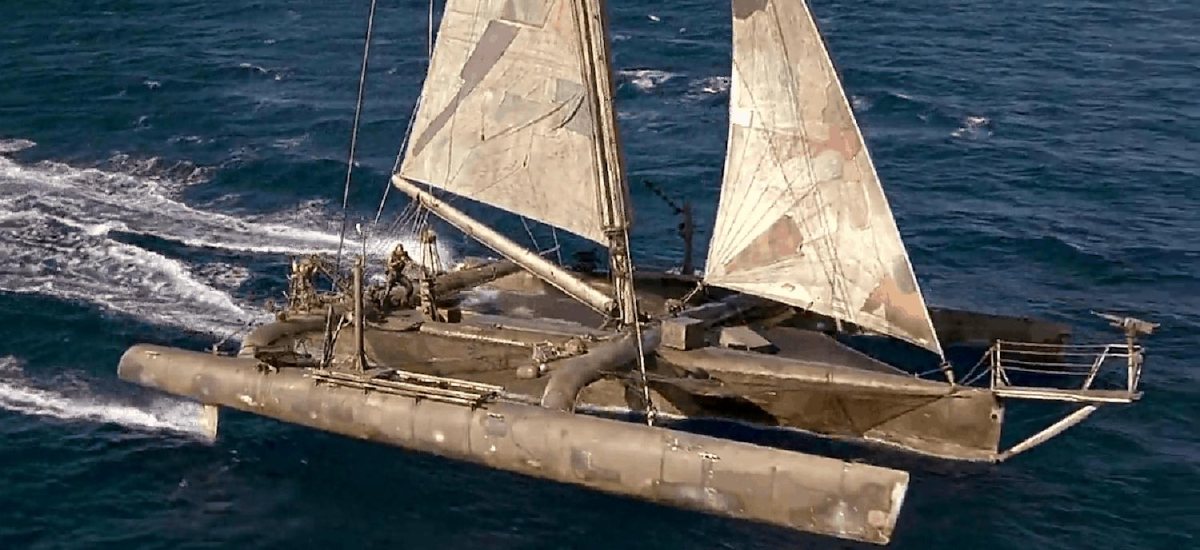
Editor’s note: This is the first post for April 2025’s The City Aquatic theme. See here for additional entries in the theme.
Thirty years ago, Universal Pictures released Waterworld, directed by Kevin Reynolds and starring Kevin Costner as a balding amphibious mutant who traverses the world on his trimaran, a boat that film critic Roger Ebert noted appeared to be constructed “out of spare parts from Mad Max.” Jack Black described the script in similar terms, calling it “a wet Road Warrior.” From the outset the movie was bedeviled by controversies– disastrous budgets, a tsunami that sunk sets, and a porous script that needed touching up by Joss Whedon (who described incorporating Costner and Reynolds’ various notes as “seven weeks of hell”) serve as a few points of struggle encountered during the production.
In the film, the global ice caps have long since melted, and most people are unaware that the planet was not always deluged. Of course, this serves as one example of the film’s silliness. “It cannot have been long since the waters rose and covered the Earth, or the sea planes, boats and guns, scavenged in abundance by human survivors, would have rusted into nothing,” noted the Guardian in a 25th anniversary retrospective.
Whatever the actual passage of time, the Earth’s inhabitants live on atolls strewn across the vast ocean of the globe, often under threat of hostile forces like the one-eyed villain, Deacon (Dennis Hopper) and his Smokers who menace Waterworld aboard a rusty but seaworthy Exxon Valdez oil tanker.
Today the movie’s ostensible environmental message seems obvious, but in the mid-1990s when climate skepticism carried larger cultural sway, it was foolish to think the film would be a blockbuster. “It was an ecological parable about a messianic mutant fish-man who drinks his own wee and sells dirt for a living, for crying out loud,” remarked the Guardian.
Out of necessity and circumstance, Costner’s nameless mariner takes on two passengers Helen (Jeanne Tripplehorn) and Enola (Tina Majarino), the former a waitress/bartender at the atoll where Costner had been imprisoned, and the latter her adopted daughter who apparently has a map to “dry land” tattooed on her back (though she’s like 11). Not to spoil it for you, but as you might have guessed, they eventually discover mythical dry land in Hawaii (the Big Island).
Over the past 30 years, the film has garnered a cult following, perhaps because of its retrospective campiness or perhaps because environmental disaster feels so much closer today. For example, the podcast How We Survive spent its second season exploring “How We Save Miami” as the Florida metropolis struggles with a variety of environmental challenges (and possible future disasters). During one sequence in the film, Costner, whose gills enable him to breathe underwater, takes an oxygen-masked Helen into the ocean’s depths to see the remnants of the world’s cities now underwater, a tragic but feasible end to South Florida’s flamboyant city.

Yet one need not focus solely on the threat of water to urban environs; obviously the relationship between water and cities is a long and deep one. Rivers, lakes, oceans, seas, and other bodies of water have often been both boon and threat to global urbanity. Cities have utilized their proximity to water for economic gain, beautification, tourism, and resources. Our theme this month, The City Aquatic (thanks Wes Anderson!) focuses on this very relationship.
It isn’t the first time we’ve turned our attention to such issues–we’ve published works on flood control in 20th century Manila and how it drove political discourse, Mexico City’s location on a lake and the complications of such an existence, Baltimore’s construction of a world class aquarium as part of its efforts to reorient residents’ relationship to the ocean and science while also increasing tourism, and the impact of colonial water sanitation systems in Nairobi, among other pieces. That said, we’ve never dedicated a month to the topic until now. Our contributors for the month explore hidden urban subterranean rivers, Milwaukee’s “Fresh Coast”, Canton’s floating cities, tourism and environmentalism around Kenya’s Lake Nakuru, the fishing economies of the Indonesian archipelago, and sanitation efforts in colonial Taiwan.
While putting together the posts for this theme month cost far less than Waterworld, which was at the time the most expensive movie ever produced, we hope that they’ll provide an even more thought-provoking window into the subject.





